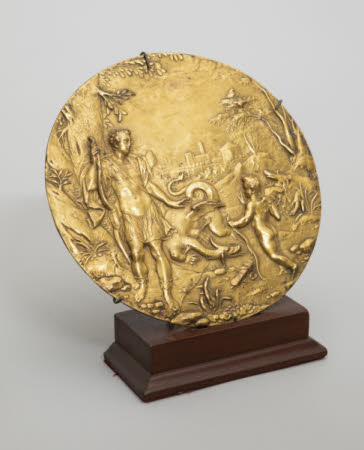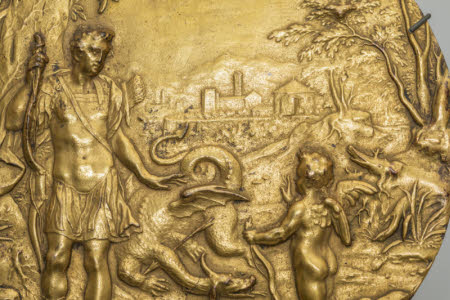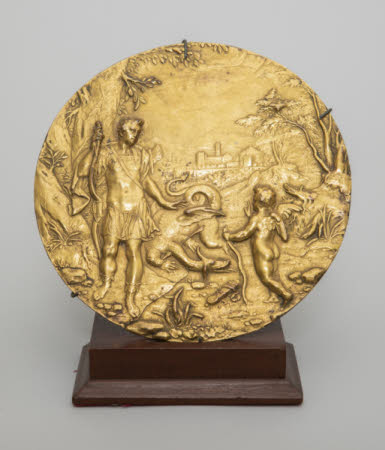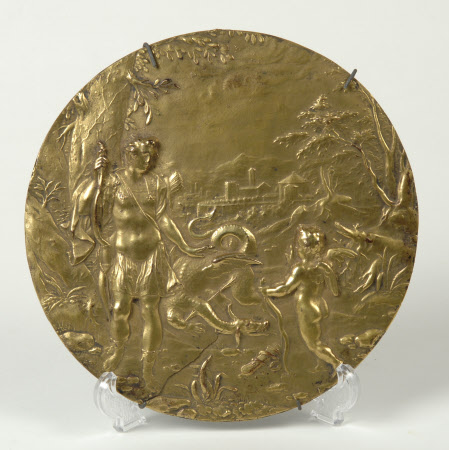Apollo, Cupid and the Dead Python
workshop of Paulus Willemsz van Vianen (Utrecht c.1570 - Prague 1613)
Category
Art / Sculpture
Date
c. 1600 - 1620
Materials
Bronze
Measurements
197 mm (7 ¾ in) Diameter
Place of origin
Prague
Order this imageCollection
Kingston Lacy Estate, Dorset
NT 1255222.1
Summary
Sculpture, gilt-bronze; Apollo, Cupid and the dead Python; Paulus van Vianen (c. 1570-1613) and workshop; c. 1600-1620. One of a set of four gilt-bronze roundels featuring scenes from the Roman poet Ovid’s Metamorphoses, designed by the Utrecht-born silversmith Paulus van Vianen. Part of a series of at least twelve designs, which would have been used in objects made from silver such as shallow dishes (tazze), but were also reproduced in bronze and in lead. The four plaquettes now at Kingston Lacy possibly come from the large group of Netherlandish and German plaquettes recorded in the collection of King Charles I, in his Cabinet Room at Whitehall Palace, in 1638 or 1639.
Full description
A gilded bronze roundel depicting Apollo, Cupid and the dead Python. The scene is set within a verdant landscape, with a large tree at left and, in the distance, a fortified town. The god Apollo stands at left, dressed in fanciful all’antica armour, holding a bow, with which he has just slain the python, a dragon-like monster that lies on the ground at centre, an arrow through its neck. At right is the naked figure of Cupid who raises his right hand in greeting to Apollo; Cupid holds his bow, whilst his quiver lies on the ground before him. The surface of the front is gilded. A crack in the surface at 7 o’clock. Part of a series of four similar reliefs (1255222.1-4). This relief depicts a story recounted in Ovid's Metamorphoses (I. 439-49), in the account of which the aftermath of the victory is rather more important than the struggle with the monster itself. Having killed the python with ‘a thousand arrows’, Apollo decided to institute a permanent memorial to his achievement, by founding the Pythian Games, in which winners would be awarded a wreath of oakleaf. The presence of Cupid in the scene refers to the continuation of Ovid’s story (I. 450-480), which saw Cupid shoot a golden-tipped arrow at Apollo, kindling his love for the nymph Daphne, whilst the arrow he fired into Daphne was instead tipped with lead arrow, so created the opposite effect in her. The story continues with Apollo’s pursuit of the terrified nymph (see 1255222.3). The four gilt-bronze circular reliefs at Kingston Lacy all illustrate episodes from the Roman poet Ovid’s long poem ‘Metamorphoses’, which became a very popular source for artists, composers and writers from the Renaissance period onwards. All the stories in the Metamorphoses concern transformations of gods and other individuals in mythology. The set at Kingston Lacy is just part of a larger series of at least twelve large circular plaques with episodes from the Metamorphoses. The larger series included four scenes from the story of Jupiter, Juno and Io (see 1255222.2 and 4) and another four from the story of the sun god Phoebus and the death of his son Phaethon. Finally two scenes from the story of Jupiter, Juno and Callisto survive, as well as the two from the story of Apollo, Cupid and the nymph Daphne. It is possible that other lost scenes telling further episodes in these stories once existed. All the plaquettes are extremely rare, most surviving in just one or two examples in bronze or in lead, whilst a couple are only known through documentary references. The Apollo, Cupid and the dead Python is the only cast of this model known to survive in plaquette form. The group of four reliefs at Kingston Lacy is one of the two largest surviving group of these plaquettes, the other group also consisting of four reliefs, this time in lead, in the Ashmolean Museum, Oxford (Warren 2014, nos. 477-81). However, the largest group known to have existed was the eleven that formerly belonged to King Charles I and was recorded in c. 1638-39, in the Cabinet Room in Whitehall Palace, part of an extensive series of Northern European plaquettes. Most were displayed framed as pictures, including the scenes from the Metamorphoses, which hung in a vertical row on either side of a window, in circular black ebonised wood frames. They were described by the compiler of the inventory, the painter Abraham van der Doort (died 1640), as “7. round peeces in round black frames being all severall stories. And parts taken out of Ovid.” and another four on the other side “likewise in a Rowe hanging downe under another” (Millar 1960, pp. 97-99). The plaquettes were part of an important group of 35 such objects given to Charles I in the 1630s by “my Lord Cottington”, Francis Cottington (c. 1579-1652), Charles I’s pro-Spanish Chancellor of the Exchequer (for Charles’s plaquettes collection, see Warren 2014, III, pp. 731-33). They were presumably all sold during the Commonwealth sales in 1650s. Given that in 1659 Sir Ralph Bankes is known to have owned several paintings formerly in the Royal collection, it is possible that the four reliefs now at Kingston Lacy are survivors from the group of plaquettes recorded in the Cabinet Room; all four designs are among the eleven recorded by van der Doort, whilst none of them have suspension holes for their display, so are likely to have been framed originally. Paulus van Vianen was a member of a brilliant dynasty of goldsmiths, who extended the boundaries of late mannerist design in precious metalwork, through their championing of the so-called auricular style, a fluid and highly organic decorative vocabulary based on amorphous fleshy forms, some of them not unlike ears, from which the term auricular derives. The van Vianen became famous all over Europe, with their works competed for by the greatest patrons of their time. Unlike his elder brother Adam van Vianen (1568-1627), who lived and worked in Utrecht for his whole life, Paulus left the city as a young man, working between 1596 and 1601 in Munich at the courts of the Dukes of Bavaria, William V and Maximilian I, and then, from 1601 to 1603, in Salzburg for the Archbishop, Wolf Dietrich von Raitenau. In 1603 Paulus moved to Prague to enter the service of the Holy Roman Emperor Rudolf II. It was in Prague, where he remained for the rest of his life, that most of his mature works in the full auricular style were made. In the next generation, Adam’s son Christiaen van Vianen (1598-1671) moved in 1630 to London where, until the Civil War, he worked for King Charles I, who became a major patron of the van Vianen. Both Paulus, who was an excellent draughtsman, and Adam van Vianen made a number of plaquettes which are remarkable for their sophisticated handling of figure and landscape compositions. These reliefs would have been made in the first place for use in objects made from precious metal, especially silver. They would typically have been used in the footed dishes known as tazze, but were also from an early date made as independent reliefs in silver, bronze or lead, for display either framed (as they were in Charles I’s Cabinet Room) or unframed, in the latter case usually with an integral frame-like border. These plaquettes would also have been one important means by which the models were disseminated to other goldsmiths. The Apollo, Cupid and the dead Python was used by the Augsburg goldsmith Christoph Lencker (c. 1566-1613) for a tazza in the Fundación Lázaro Galdiano in Madrid (Cruz Valdovinos 2000, no. 82), bearing Augsburg marks for c. 1600-1605. The design was also reused, in considerably altered form, by Adam van Vianen on a tazza dated 1620 (Utrecht, Centraal Museum, Inv. 7895; ter Molen 1984, II, no. 414; Utrecht 1984, no. 67). Paulus van Vianen’s Metamorphoses series relate stylistically from the artist’s later period. The series must have been conceived in the very early seventeenth century, given the date of the Augsburg marks on Christoph Lencker’s tazza. Although they could have originated when Paulus was still working in Southern Germany, it is more likely that the original models were made during his years in Prague. Both stylistically and compositionally, they fit very well the taste of the Emperor Rudolf for complex, sometimes somewhat lubricious mythological scenes. Although the plaquettes have been described in the past as the work of a follower, they seem unquestionably to be products of his workshop, and were clearly identified as the work of Paulus in one of the Whitehall inventories. Jeremy Warren May 2023
Provenance
First recorded In the 1860 inventory drawn up by Rosa Louisa Bankes (1827-1878); by descent; bequeathed by (Henry John) Ralph Bankes (1902-1981), together with the estates of Corfe Castle and Kingston Lacy and its entire contents
Makers and roles
workshop of Paulus Willemsz van Vianen (Utrecht c.1570 - Prague 1613) , sculptor after Paulus Willemsz van Vianen (Utrecht c.1570 - Prague 1613) , original artist possibly Dutch School, artist
References
Millar, 1958-60: Oliver Millar, ed., ‘Abraham van der Doort’s Catalogue of the Collections of Charles I’, The Walpole Society, vol. XXXVII, 1958-60, pp. 97-99. Ter Molen 1984: J.R. ter Molen, ‚Van Vianen: een Utrechtse familie van zilversmeden met een internationale faam‘, PhD Dissertation, 2 vols., Leiderdorp 1984 Utrecht 1984: J.R. ter Molen, Zeldzaam Zilver uit de Gouden Eeuw, exh. cat., Centraal Museum, Utrecht 1984 Cruz Valdovinos 2000: José Manuel Cruz Valdovinos, Platería en la Fundación Lázaro Galdiano, Madrid 2000, no. 82. Warren 2014: Jeremy Warren, Medieval and Renaissance Sculpture in the Ashmolean Museum, 3 vols., Oxford 2014, nos. 477-81.




